| |
February 2016
|
 How How

Leveson

Frazzoli

Masterson
|
1. Honors and awards
Professor Jon How has been elected a Fellow of the American Institute of Aeronautics and Astronautics. Election as an AIAA Fellow is among the highest honors bestowed by the aerospace community.
The International Association for the Advancement of Space Safety has named Professor Nancy Leveson recipient of its 2016 Vladimir Syromyatnikov Safety-by Design Award. The award honors “distinguished individuals who have made major technical contributions toward the safety of space systems.”
Emilio Frazzoli, along with several co-authors, has been awarded the IEEE Control Systems Society's 2015 George S. Axelby Outstanding Paper Award for their paper, “Robust Distributed Routing in Dynamical Networks–Part II: Strong Resilience, Equilibrium Selection and Cascaded Failures."
Space Systems Lab Research Scientist Dr. Rebecca Masterson has been named a recipient of the Infinite Kilometer Award. The Infinite Kilometer Award was established by the MIT School of Science to highlight and reward the extraordinary, but often under-recognized work of research staff and postdocs. |
| |

2. Welcome
Welcome to the following new members of the AeroAstro family: Rebecca Morrison, postdoc associate with Professor Marzouk; Jayant Sabnis, senior lecturer with Professor Greitzer; Matteo Seregni, postdoc fellow with Professor Hoffman; Panagiotis Natsiavas, postdoc associate with Professor Radovitzky; William Guyster, research affiliate with Professor Harris. and Khai Pham, postdoc associate with Professor Radovitzky. |
| |

3. Rocket Team enthralls >1,000 at Science on Saturday
MIT Rocket Team president Eric Riehl reports: "The Rocket Team, with 24 volunteers, hosted a "Science on Saturday" event at Kresge Auditorium on February 6. More than 1,000 attendees, mostly elementary school students, enjoyed a presentation by the team showcasing the basics of rocketry with fun experiments like balloon launching, placing students to scale distances of space objects, and vinegar/baking soda rockets. After the show, students enjoyed hands-on activities including paper airplanes/rockets/helicopters, scale models of rockets, geology stations, flight simulators, and balloon string races. The MIT Rocket Team hopes it inspired the children to pursue science and be curious!"
Science on Saturday, a program of the MIT Museum, are free, 60-minute presentations with fun demonstrations in which students can volunteer. Each Saturday morning program is open to all elementary, middle, and high school students, as well as their parents and teachers.
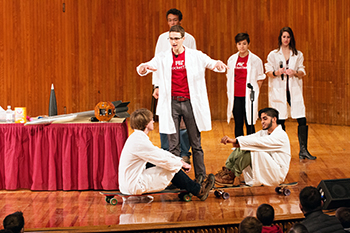
Rocket Team members demonstrate the third law on the Kresge stage during their Science on Saturday program. Pictured are (from left, front) Zachary Bierstedt, Matt Vernacchia, Samir Wadhwania, (rear) Andrew Adams, Caitlin Fischer, and Julia CrowleyFarenga. |
| |

4. Open House activities planned
More than 20 AeroAstro labs, student groups, and individuals have signed up to participate in MIT's April 23 Open House. The event is part of the Institute's celebration of the Cambridge campus centennial. Upwards of 30,000 visitors are expected to attend. AeroAstro activities for the day will include:
- Paper airplane build and fly competition - Patrick Blonigan
- Ladies Tea Time at AeroAstro - WGA^3
- Man Vehicle Lab tours and demos - MVL
- Design-Build-Fly Team display - DBF
- SPHERES interactive demos - SSL
- Fly a virtual airplane - ICAT and Flying Club
- Egg parachute drop - AIAA
- Air-propelled rocket build/launch - GA^3
- Wright Bros. Wind Tunnel demos - Dave Robertson, WAE
- Model rocketry - Jim Clark, Rocket Team
- Aviation and the Environment - LAE
- UAVs in Action - ACL
- Self-driving car testbeds - ACL
- Interactive Robotics Lab tours/demos - IRL
- Up close with jet engines - Prof. Zolti Spakovszky/GTL
- Space Propulsion Lab tours - SPL
- Tiny materials - necstlab
- D-8 double-bubble - D-8 team
- Mars habitation panel - Sydney Do, Andrew Owens, SERG
- STAR Lab tours - STAR Lab
- Systems Engineering Research Laboratory display - SERL
In addition, AeroAstro is coordinating a US Navy UAS/UAV display, a Terrafugia drivable airplane visit, and potential fly-in/displays of Air Force, Army, and Navy aircraft. To see an in-progress list of all MIT Open House activities, visit bit.ly/20H4FDs. If your lab or group is interested in participating and has not submitted an activity, please contact Bill Litant.
|
| |

5. Women in Aerospace Symposium planning underway

Plans for the Department's May 24-26, 2016 Women in Aerospace Symposium are underway. The Symposium offers outstanding women doctoral and postdoctoral researchers a unique opportunity to present their work to, and network with, their colleagues, MIT faculty, and industry/government professionals. The Symposium includes technical presentations, discussion with faculty, talks by leaders in the aerospace field, and panel discussions about academic careers. Participants will exchange views on the future of aerospace engineering, strengthen career-building networks, and learn about pursuing academic careers. Approximately 20 attendee presenters will be selected through a competitive application process. Applicants must be women a year from, or up to two years following, receipt of their doctoral degree, and have an interest in pursuing a career in academia. Travel grants will be offered. The planning committee includes professors Julie Shah, Leia Sterling, and Jaime Perarie, and AeroAstro staff Joyce Light, Jean Sofronas, and Bill Litant. The agenda, application form, and other information are posted on the AeroAstro website. |
| |

6. KitCube a contender for lunar hitchhike
An AeroAstro student team is a top contender in the NASA CubeQuest Challenge, a competition offering the winners’ projects a ride aboard the Exploration Mission-1.
Exploration Mission-1 is the first planned flight of NASA’s new heavy-launch Space Launch System (SLS-1) and the second uncrewed flight of the Orion Multi-Purpose Crew Vehicle, the successor spacecraft to both Apollo and the Space Shuttle. In addition to the opportunity to fly a CubeSat miniaturized satellite into deep space or lunar orbit, NASA also is offering $5 million in prize money for technology demonstration categories such as achieving lunar orbit, the best burst data rate, and advances in navigation, propulsion, and communications.
The MIT team’s entry, called KitCube, is a backpack-size satellite that would receive a boost toward lunar orbit on the NASA vehicle, and then be deployed as an independent spacecraft. New technologies that KitCube will demonstrate include a compact laser communications transmitter that uses an ant-size fine-steering mirror to point a narrow laser beam from the moon to a receive telescope on the Earth. The spacecraft will also use other sensors and actuators, such as miniature star-tracking cameras and reaction wheels, to stay pointed at the telescope.
MIT’s Team KitCube encourages all interested space enthusiasts at MIT to join the project. Individuals can contact kcahoy@mit.edu or racheliw@mit.edu to learn more.
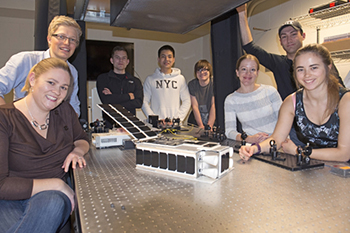
Team KitCube members include: (l-r) grad student Kate Cantu, senior Johannes Norheim, junior Bjarni Orn Kristinsson, grad student Myron Lee, grad student Christian Haughwout, grad student Angie Crews, grad student Max Yates, and senior Scarlett Koller. |
 Cahoy Cahoy

Karaman

de Weck

Marzouk
|

7. Newsbriefs
Professors Kerri Cahoy and Sertac Karaman have been promoted to the rank of associate professor without tenure. Announcing the promotions, AeroAstro Department head Jaime Peraire wrote, "Kerri and Sertac have demonstrated tremendous leadership and excellence as researchers and educators, and we are fortunate to have them in the Department and at MIT." The promotions take effect July 1.
Late last year, Professor Oli de Weck co-taught a professional education program for individuals from South Africa’s manufacturing industry, who came to MIT for a five-day intensive program focused on manufacturing and product platforms. The program addressed such topics as product platforming, product architecting, platform strategy, and two-sided markets.
Baby Taha Gabriel was born to Professor Youssef and Stephanie Young Marzouk on January 16. Congratulations to the proud parents.
On noting the passing of Apollo 14 astronaut and AeroAstro alumnus Dr. Edgar Mitchell (ScD '64), Professor Larry Young writes: "We lost a friend and a major contributor to the space program with the passing of Ed Mitchell. We were grad students together in the Instrumentation Program and we shared an office, along with Walt Hollister, I believe, on the ground floor of Building 33. We discussed space exploration daily. He was one of four MIT grads - three from AeroAstro -to walk on the moon. He had a strong interest in parapsychology, and was not hesitant to discuss the spiritual side of space travel. In recent years he spoke to our Apollo class and spent a day helping us evaluate our proposed lunar landing display at the Draper Lab. He was a credit to our Department and to the space program.
Frank Durgin, associate director of the Wright Brothers Wind Tunnel from 1966 until 1992, passed away on January 19 at age 89. In recent years, Frank participated in the group examining WBWT’s rehabilitation. He last visited the Department in 2015 to drop off documents relating to various research projects conducted in the tunnel.
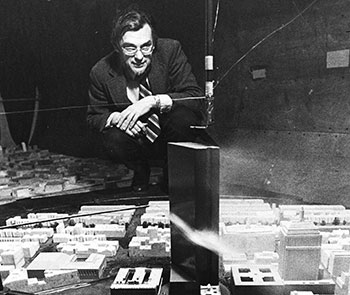
Frank Durgin examines a model of Boston's John Hancock Tower in the Wright Brothers Wind Tunnel. Soon after the building's 1976, windows began popping out. The MIT testing followed and helped lead to alterations in the tower’s construction.
The Graduate Association of Aeronautics and Astronautics' new executive committee has assumed office: Charlotte Lowey and Alison Gibson, co-presidents; Richard Fineman, vice president; Shun Zhang, treasurer; Akshata Krishnamurthy and Forrest Meyer, graduate student council representatives; Ayesha Hein, Cory Frontin and Zhiyi Wang, intramural sports chairs; Sandro Salgueiro, international chair; Hugh Carson, Timothy McGrath, and Chika Eke, social chairs; Parker Vascik, academic chair; Antonio Espinoza, webmaster.
Google Project Wing Lead Adam Woodworth ('07) was the featured speaker at the 2016 Academy of Model Aeronautics Conference in Ontario, Calif. last month. Retired AeroAstro lecturer Col. Pete Young ('67), who attended the conference, writes that Adam "recounted his lifelong passion for aeronautics, detailing his MIT AeroAstro experiences in quite some detail, and then describing his current responsibilities developing Google's drone aerial delivery system. He gave a shout out to Unified, Mark Drela, the Gelb Lab, OCW, among other things."
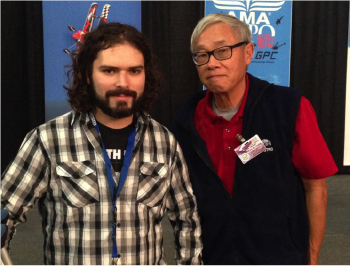
Adam Woodworth (left) and Col. Pete Young at the 2016 Model Aeronautics Conference.
|
|

8. In the picture
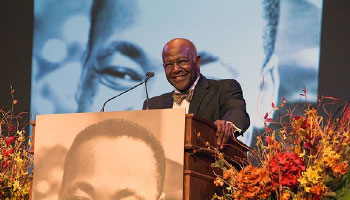
Professor Wes Harris delivered Princeton University's 2016 Martin Luther King Day Commemoration key address. Professor Harris received his MA ('66) and PhD ('68) from Princeton.
___________________________________
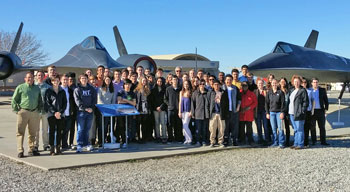
Course 16 students, faculty, and staff pose in front of Lockheed SR-71 and A-12 aircraft at Edwards AFB's Blackbird Airpark annex during their January Department-sponsored trip to the West Coast. An annual event for AeroAstro sophomores, the trip also included visits to Boeing, Lockheed Martin, JPL, SpaceX, Virgin Galactic, and Northrup Grumman.
___________________________________
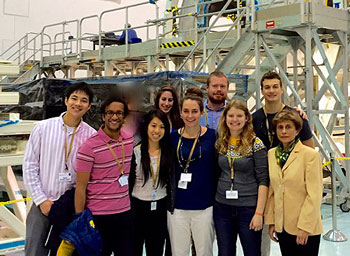
During the 2016 Independent Activities Period, a group of AeroAstro students was treated to a visit to the Kennedy Space Center where they were briefed by NASA engineers, scientists, and managers. The trip was sponsored by the Massachusetts Space Grant Consortium.
___________________________________
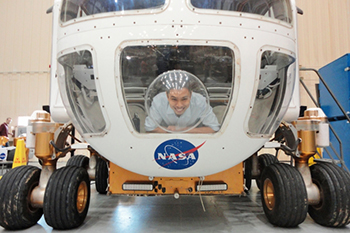
AeroAstro grad student Sydney Do peers from the front window of NASA’s drivable Mars rover prototype at the Johnson Space Center in Houston. Sydney is working with NASA and FUSION TV to create a super-authentic Mars VR experience "Mars 2030." More here.
|
 
|

Follow AeroAstro
Don't wait for your enews and emails — keep up with AeroAstro news as it happens — follow the Department on Twitter and Facebook. |
|
If you know of events, honors, activities, or other information you'd like to see in the next issue of AeroAstro enews, please send to wlitant@mit.edu. |
|
|

 How
How





 Cahoy
Cahoy







